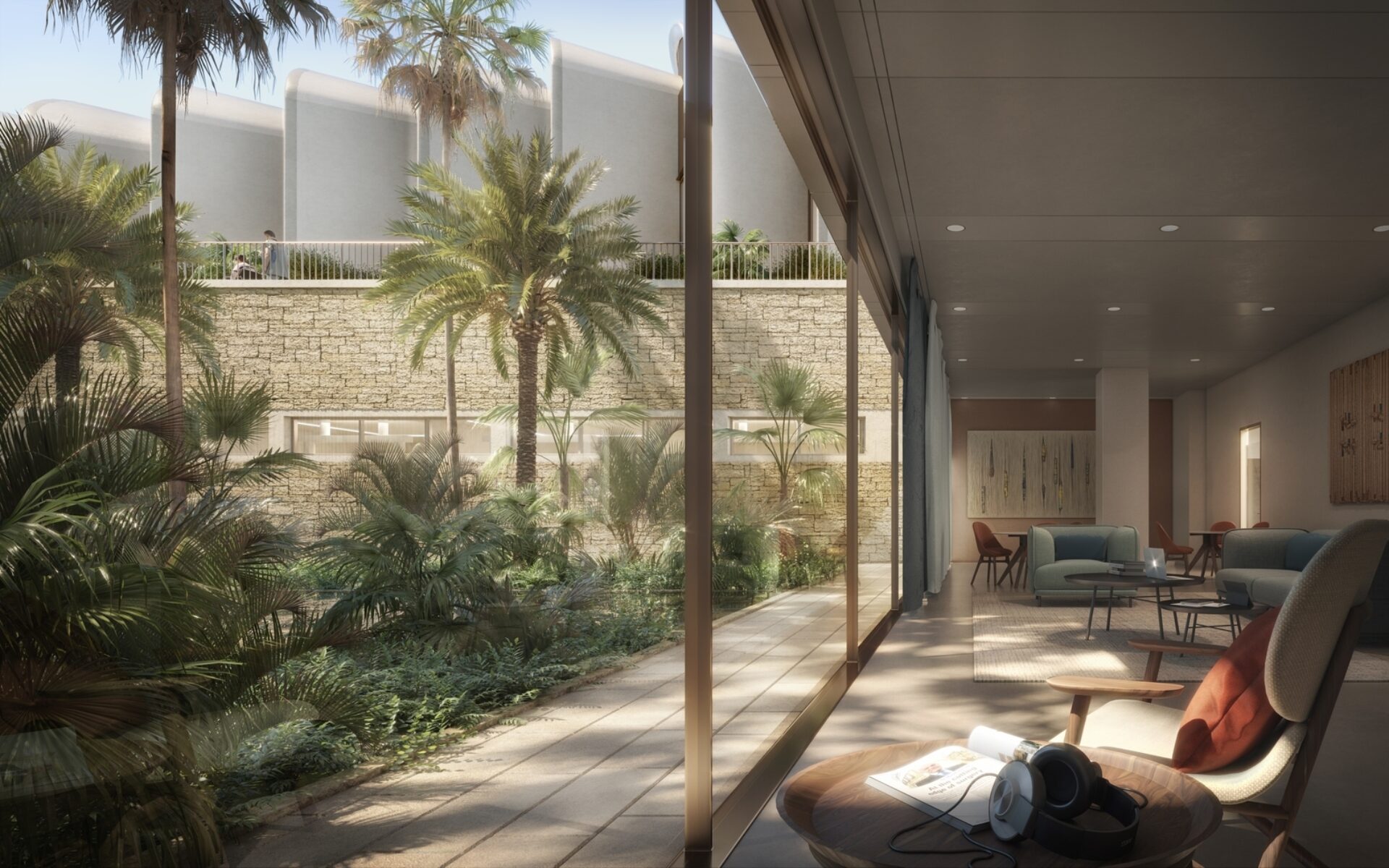(Above: Magdi Yacoub Global Heart Centre, Cairo, image courtesy of Foster Partners)
After months of being stuck at home, a pandemic-weary population is (understandably) craving the natural world—even when they’re inside.
Designers have long known the deal: Adding biophilic elements to a space can reduce stress, boost cognitive function and creativity, improve wellbeing, and expedite healing. The current crisis only reinforced the need to bring the outside in.
“There has been a general surge in awareness that nature plays a fundamental role in helping to maintain one’s physical and mental wellbeing,” says Oliver Heath, director of Oliver Heath Design, a firm specializing in biophilic design in Brighton, England. “When people started to work from home and had far less spatial diversity in their lives, they realized that the four walls that surround them actually have an enormous impact on their physical and mental well-being.”
In Bloom
The Magdi Yacoub Global Heart Center in Cairo, designed by British firm Foster + Partners, represents biophilia writ large. Slated for completion in 2023, the project is meant to evoke an oasis amidst the desert, with abundant greenery, a network of linear waterways, and natural light, as well as an undulating, shell-like roofscape. Multiple courtyards with views of a tranquil lake—as well as of the pyramids of Giza—are another nod to the natural world.
“Extensive evidence demonstrates that biophilic environments—ones that incorporate real elements as well as those that mimic nature—exert a healing effect on the human body,” says Iwan Jones, partner and project lead, Foster + Partners, London.
“The relationship between the users, the local climate and ecology, and the local vernacular was key in creating a more productive and welcoming environment. We wanted to maximize natural light and enhance visual connectivity between the inside and out. The design creates a tangible relationship to water not just visually, but also at an environmental and psychological level.”
Biophilia can also affect the ethos of office spaces and is likely to play a role in a broader transformation of workspaces in the wake of the COVID-19. While most people will eventually return to the office, research indicates many are likely to do so only two or three days per week continuing to work from home on the other days. That means the office could take on a different, more specialized role—one that’s in line with biophilic principles.
“People will be coming into work looking for a sense of purpose, social connection, and collaboration, and designers are going to have to put elements into those spaces that make the workplace a destination for life, not just work,” says Upali Nanda, principal and director of research at HKS and associate professor of practice at Taubman College of Architecture, Ann Arbor, Michigan. “We haven’t had that before, but biophilia can help us see the office as a thriving space where life flourishes, a place that fosters connection with nature as well as connection with people and society.”
Biophilic elements can spark that shift in point of view, for instance the use of living walls instead of partitions—even incorporating natural materials like cork and bark that encourage tactile interaction make a difference. Curves, fractals, fresh air, natural light, and dynamic elements that change by season or time of day all serve to make the interior spaces feel more natural.

Image courtesy of Freyfuss Blackford
(Above: Contra Costa County Emergency Operations Center, image courtesy of Freyfuss Blackford)
“That’s what biophilic design does so well—it alleviates some of the geometric regularity and harshness of the modern built environment,” Heath says. The challenge for designers is to figure out how to use natural and nature-evoking elements to "create exciting, stimulating, aspirational spaces where people want to go, and that are also supportive, recuperative. and restorative.”
It's much more than just bringing physical elements of nature into built environments: People can derive biophilic benefits from simulations of natural phenomena, too. The Natural Resources Defense Council, for example, integrates biophilic elements in all its offices, including pictures of foliage in a honeycomb pattern at its San Francisco office.
Taken together, these options provide designers with a broad palette of solutions to bring the outdoors inside.
The Biophilic Continuum
People have flocked to the outdoors during the pandemic and that’s a healthy development, says Heath, who believes that biophilia is best considered on a continuum.
And designers have a role to play in the center of that continuum, introducing biophilic elements into spaces and even extending into the great outdoors. Last July, for example, several Toronto fitness studios teamed up to create Lmnts Outdoor Studio, offering classes in 50 private clear geodesic domes. In other cases, urban offices are introducing rooftop terraces.
Expect more of those blended environments: California design firm Dreyfuss+Blackford included a conference room in the new Contra Costa County Sheriff’s Emergency Operations Center (above)—and allowed the back wall to open up entirely to a shaded patio via a glass garage door.
“Open spaces not only aid in social distancing, but they fulfill a fundamental role in fostering a sense of wellbeing in people’s lives,” Jones says. “This shows that biophilic design can help create more resilient settlements, strengthening the relationship between humankind and nature.”

